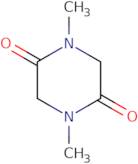Informação sobre produto
- 1,4-Dimethyl-2,5-dioxopiperazine
- 1,4-Dimethyl-2,5-piperazinedione
- 2,5-Piperazinedione, 1,4-dimethyl-
- 2,5-Piperazinedione, 1,4-dimethyl- (8CI)(9CI)
- Cyclo (sar-sar)
- Cyclo(sarcosylsarcosyl)
- N,N'-Dimethyldiketopiperazine
- Nsc 67461
- Sarcosine anhydride, bimol. cyclic
- Sarcosine diketopiperazine
- Ver mais sinónimos
- 1,4-Dimethylpiperazine-2,5-dione
Sarcosine anhydride is a polymer that has been synthesized by the reaction of sarcosine and formaldehyde. It has been used to produce films that have a variety of applications, including in the biomedical field as an anti-fouling agent for medical devices. Sarcosine anhydride can inhibit bacterial growth by binding to cell wall proteins and inhibiting their synthesis. The film also inhibits collagen production and fatty acid synthesis, both of which are vital for the proliferation of cells. This polymer is composed primarily of amide groups with phenyl groups attached to each end. The active substances in sarcosine anhydride are primary amino acids, caffeine, and carbonyl groups. These substances are metabolized by humans at different rates; for example, caffeine is metabolized more quickly than glycine or serine. The activation energies for these reactions vary according to the type of substance present; for example, glycine has a lower activation energy than serine because it





